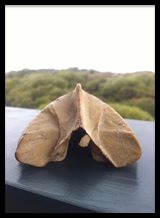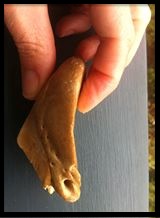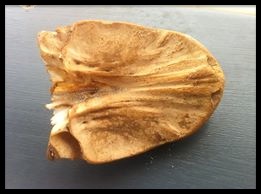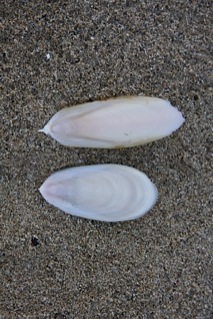
Sarah: Tucked away down here at the bottom of Yorke Peninsula, we solved an Easter mystery by social media.
The case began whilst on a family beachcombing foray. My 6-year old niece ran towards me holding the item shown in the photograph above,
“Aunty Sarah, what is this?”
I did not know, but described to her the features I could see.
“It’s made of bone, and looks a bit like a vertebra, or one of the bones in a spine. It is symmetrical, which means it would be the same on each side if you chopped it in half along its length. It has flat spines which stick out from one end, and has small holes on each side which you can imagine nerves might come out from in the living situation”
But it wasn’t a bone from a spine of any animal I knew; the unusual rounded end ruled out this possibility. We googled various bone images and came up with nothing. It had us truly flummoxed.
Not just us, but also a group of interested followers on twitter and Facebook. After I posted the following photographic angles….




…the comments came rolling in thick and fast:
“Almost looks like the front of the scull of a bottle-nosed dolphin”
“Vertebra was going to be my guess too, overall I have no idea! I do hope it turns out to be a sperm whale tooth!!!”
“At the risk of being a total dunderhead, It looks like an occipital bone/saggital crest on a parietal skull bone but where is the rest of the skull?! Seal? Foetal something? I have no idea, but this is super fun”
“ALIEN”
“Looks like a beak of some kind of bird”
“It looks like mammal bone”
“Agree. Don’t know exactly what it is but it doesn’t look fish-y to me”
“Is it ambergris?”
“True looks like a vertebra. I’d only be guessing. But looks old and well worn. Whale?”
On a whim, I forwarded my images to the twitter account of the South Australian Museum (@SAMuseum). I sat, I waited, it was killing me!
Two days later, a JACKPOT response from the museum.
“Found! This is the bone that forms the hump on the head of a Snapper fish (Chrysophrys auratus)”
Mystery solved! Now I can sleep. Thanks museum staff and all who followed along.
P.S. You can see the bone above the eyes of this X-ray image of a snapper head here. This is the bone that sometimes undergoes abnormal growth and gives some snapper their famous ‘bumpy nose’ appearance.
P.P.S. And for the record, some of the people whose comments are shown above were actually very close. You know who you are!




























